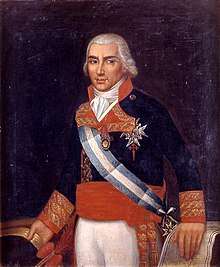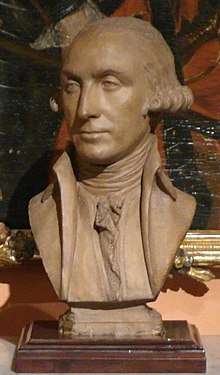Federico Gravina
Federico Carlos Gravina y Nápoli (August 12, 1756 – May 9, 1806) was a Spanish admiral during the American Revolution and Napoleonic Wars. He died of wounds sustained during the Battle of Trafalgar. Spanish explorer Jacinto Caamaño named the Gravina Island in Alaska in his honor.
Federico Gravina | |
|---|---|
 Portrait at the Museo Naval de Madrid | |
| Born | August 12, 1756 Palermo, Sicily |
| Died | May 9, 1806 (aged 49) Cadiz, Spain |
| Allegiance | |
| Service/ | |
| Years of service | 1768–1806 |
| Rank | Admiral |
| Battles/wars | American War of Independence |
Origins and military career
The Gravinas were part of the Sicilian aristocracy, as they were directly descended from the Normans who conquered Sicily. He was the son of Juan Gravina y Moncada, Duke of San Miguel, Grandee of Spain, and Doña Leonor Nápoli y Monteaporto, daughter of the Prince of Resetena, also Grandee of Spain.[1] His maternal family originated in Sicily, which was then part of the Kingdom of Naples and ruled by a Spanish Bourbon dynasty. With the help of his uncle, the Neapolitan Ambassador to Spain, he entered the Spanish Navy, as a naval cadet aged 12. He then served as Midshipman on board the frigate Santa Clara in Brazil. In the course of this voyage, he carried out his first command when obtaining the surrender of the castle of the Ascensión, located in a small barren island near Santa Catalina. In 1777 he survived a boat accident in the River Plate in which most of the crew drowned. In 1778, on returning to Spain, he served as a lieutenant aboard a ship suppressing Algerian pirates. He then obtained his first command – the polacre-rigged xebec San Luis – in which he participated in the Siege of Gibraltar between 1779 and 1782, capturing the British corvette HMS St Fermin.

After promotion to Commander he participated in the expedition against Menorca (then under British control), distinguishing himself in the attack on the fortress of San Felipe. After this, and for other actions, he was promoted to Captain. In 1785 he commanded a squadron operating against Algerian corsairs. In 1788 he travelled to Constantinople returning the Ambassador Jussuf Efendi. While there he made and published various astronomical observations. After the death of King Charles III, Gravina took the news to the colonies, where his frigate Paz recorded one of the fastest-ever times for passages from Cadiz to the Spanish possessions in Central America.
In 1790 he was given command of a ship-of-the line, the Paula, in which he took part in the evacuation of Oran. The same year saw him demonstrate his administrative talents for the first time. During the Nootka Sound Crisis, Gravina organised the formation of a Spanish fleet, the largest in 200 years. However, the crisis was eventually solved by diplomatic means.
In 1793 Gravina, now second in command of the Spanish fleet, served alongside Admiral Hood in the Siege of Toulon. During this period of the alliance with England he also visited Portsmouth to study British methods and tactics. On his return to Spain he was appointed to command a squadron of four ships, with which he served in the Mediterranean taking an active part in the war against Revolutionary France. His flagship was the Hermenegildo (112).
In 1796 Spain signed the treaty of San Ildefonso with France, making peace and later entering the war against Britain. Gravina served in a squadron under Don Jose de Mazarredo. In 1801 he was sent to San Domingo in the West Indies in command of the Spanish fleet during the Haiti expedition under the French General Charles Leclerc.
In 1804 he was appointed Ambassador to France in Paris. He accepted this position on one condition: if war should break out he would immediately return to the military.
While in Paris he attended Napoleon's coronation as Emperor, and established good relations with Denis Decres, the French Naval Minister. Gravina played a major part in the negotiations of the Franco-Spanish pact which put the Spanish Navy at Napoleon's disposal. For his services King Charles IV appointed him Commander-in-Chief of the Spanish Navy, and Gravina returned to Cadiz to hoist his flag in the ship Argonauta (80) in February 1805.
Trafalgar

When Napoleon proposed to invade Great Britain, following the orders of the government of Godoy, Gravina was placed under the command of French Admiral Villeneuve, who took the Franco-Spanish fleet into Caribbean waters to confuse the British fleet. The objective was to allow the crossing of the English Channel by 180,000 men that Napoleon had waiting around Boulogne. The deception did not have desired effect. On its return the Franco-Spanish fleet was intercepted by a fleet under Sir Robert Calder at the Battle of Cape Finisterre, losing the Spanish ships Firme and San Rafael. After this they took refuge in Cádiz by order of Villeneuve, contradicting the original plan of Napoleon. The French soldiers never embarked, and were moved to the interior of Europe, freeing many of them to take part in the Battle of Austerlitz. He later moved his flag to Principe de Asturias.
In Cadiz relations between the supposed allies were poor. Gravina and other Spanish commanders argued strongly with the French, who wanted to sail immediately, whereas the Spaniards recommended waiting for more favourable conditions. Gravina was also concerned about the yellow fever epidemic that had left his ships short of men, as well as the lingering resentment against the French, for their perceived lack of support at the Battle of Cape Finisterre. The fleet finally left Cadiz on October 20, 1805, leading to the Battle of Trafalgar the next day.
During the battle Gravina, in his flagship Principe de Asturias, found himself attacked by three British ships at once. The main mast and mizzen were shot through, rigging and sails shot to pieces. At about half past three in the afternoon Gravina's left arm was shattered by grapeshot, and seeing a looming defeat, he managed to gather ten ships around his flagship and fell back to Cadiz under tow.
Despite this Gravina was promoted to the highest military rank of Capitán-General de la Armada (Admiral of the Fleet), but he never fully recovered from his wounds and finally succumbed on May 9, 1806, aged 49.
On his deathbed he said, "I am a dying man, but I die happy; I am going, I hope and trust, to join Nelson, the greatest hero that the world perhaps has produced."

In turn the Gibraltar Chronicle paid the following tribute, "Spain loses in Gravina the most distinguished officer in her navy; one under whose command her fleets, though sometimes beaten, always fought in such a manner as to merit the encomiums of their conquerors."
As Napoleon wrote in a letter of August 11, 1805: "Gravina is all genius and decision in combat. If Villeneuve had had those qualities, the battle of Finisterre would have been a complete victory".
Gravina is buried at the Panteón de Marinos Ilustres in San Fernando, Cadiz.